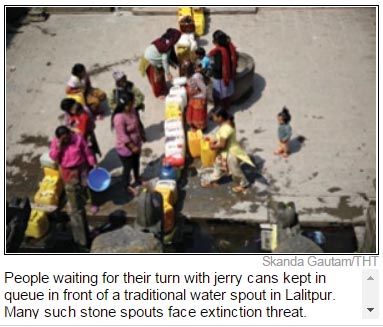
HIMALAYAN NEWS, KATHMANDU:There was a time when the Kathmandu Valley boasted 389 traditional stone spouts. But now these centuries-old stone spouts, which survived even earthquakes, are under severe threat. Experts say haphazard urbanisation and population explosion could soon lead them to extinction.
According to the Forum for Urban Water and Sanitation, currently there are 233 water spouts that are working naturally. Sixty-eight such traditional stone taps have run dry and 45 of them do not exist at all, says the NGO.
Undependable government supplies still leave many in the capital city to rely on these spouts, as other private alternatives are expensive. These spouts, carved with Hindu and Buddhist deities, are still a source of cultural and religious inspiration in this ancient city with temples galore, where many functions and pujas require ‘pure water’ fetched from such sources, and in the meantime, they are testimony to the Valley’s rich culture. In the thirsty capital, extinction of such traditional stone spouts could spell a disaster, say experts.
Officials say the Department of Archaeology, Kathmandu Metropolitan City, Lalitpur Sub-Metropolitan City, Bhaktapur Municipality, Madhyapur Thimi Municipality, Kirtipur Municipality, Historical Stone Spout and Source Conservation and Forum for Urban Water and Sanitation are working in close connection to revive and preserve the water spouts since 2010. According to a 12-point declaration on stone spouts conservation issued in June 2007, the government had expressed commitment to identify the sources of stone spouts, formulate conservation policies, map the spouts, declare them national heritage, manage water sources, allocate the budget, carry out research and make laws to check the use of ground water.
“Discouraging rapid and haphazard urbanisation, industrialisation and concrete constructions could help preserve the stone spouts,” says Anil Sthapit, Secretary, Forum for Urban Water and Sanitation. “The government should revive the culture of ancient water spouts by connecting modern water pipeline supplies with non-functioning water spouts.”
Sthapit expressed concerned that the government had precious little to conserve the 273 water spouts which are still functioning naturally. Rapid urbanisation has blocked underground water channels that fed the stone spouts.
The households, construction firms, hotels and industries are digging wells, limiting the flow of water to water spouts. Unchecked drawing of groundwater in the Valley has led to decrease in the level of groundwater causing the water spouts to run dry with each passing year, says Sthapit. Sthapit says urgent action is needed from all sides — government to private sector — to conserve these traditional stone spouts.